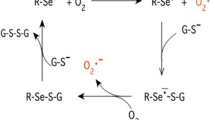Abstract
Strains of Escherichia coli, Proteus mirabilis, Pseudomonas aeruginosa, Enterococcus faecalis, and Klebsiella pneumoniae, mostly from complicated urinary tract infections, showed reduced adherence to silver-treated silicone or latex catheters as compared with latex or silicone catheters. The relative degrees of cell adherence to catheters at 2 h or 18 h, as indicated by radiolabeled cell assays, were in general agreement with growth rate-reduction assays and scanning-electron-microscopy data. For strains of E. coli, the correlation between cell hydrophobicity and degree of adherence to catheters was not significant. Antibiotic resistance (tetracycline, sulfathiazine, neomycin, kanamycin) and silver resistance were not associated. The radiolabel adherence procedure provided a quantitative method for evaluating the relative antimicrobial efficacy of silver-treated catheters.
Similar content being viewed by others
Literature Cited
Akiyama H, Okamoto S (1988) Prophylaxis of indwelling urethral catheter infection:2 clinical experience with a modified Foley catheter and drainage system on catheter-associated bacteriuria. J Urol 139:69–73
Berger TJ, Spadro JA, Chapin SE, Becker RO (1976) Electrically generated silver ions: quantitative effects on bacterial and mammalian cells. Antimicrob Chemother 9:357–358
Grewal JS, Tiwari RP (1990) Resistance to metal ions and antibiotics in Escherichia coli isolated from food stuffs. J Med Microbiol 32:223–226
Hill WR, Pillsbury DM (1939) Argyria, the pharmacology of silver. Baltimore: The Williams & Wilkins Co.
Horan T, Culver DW, Jarvis W, Emori G, Banerjee S, Martone W, Thornsberry C (1988) Pathogens causing nosocomial infections: preliminary data from the national nosocomial infections surveillance system. Antimicrob Newslett 5:65–67
Johnson JR, Roberts PL, Olsen RJ, Moyer KA, Stamm WE (1990) Prevention of catheter-associatedd urinary tract infection with a silver oxide-coated urinary catheter: clinical and microbiological correlates. J Infect Dis 162:1145–1150
Kaur P, Vadehra DV (1986) Mechanism of resistance to silver ions in Klebsiella pneumoniae. Antimicrob Agents Chemother 29:165–167
Kunin CM (1987) The concepts of “significant bacteriuria” and asymptomatic bacteriuria, clinical syndromes and the epidemiology of urinary tract infections. In: (ed) Detection, prevention and management of urinary tract infections, 4th ed. Philadelphia: Lea and Febiger pp 57–124
Kunin CM (1988) Can we build a better urinary catheter? N Engl J Med 319:365–366
Lennette EH, Balows A, Hausler WJ Jr, Shadomy HJ (1985) Manual of clinical microbiology, 4th ed. Washington, DC: American Society for Microbiology
Liedberg H, Lundeberg T (1990) Silver alloy coated catheters reduce catheter-associated bacteriuria. Br J Urol 65:379–381
Liedberg H, Lundeberg T, Ekman P (1990) Refinements in the coating of urethral catheters reduce the incidence of catheter-associated bacteriuria. An experimental and clinical study. Eur Urol 17:236–240
Lundeberg T (1986) Prevention of catheter-associated urinarytract infections by use of silver-impregnated catheters. Lancet 1:1031
Maniatis T, Fritsch EF, Sambrook J (1989) Extraction and purification of plasmid DNA. In: Molecular cloning, a laboratory manual, 2nd ed. Cold Spring Harbor, N.Y.: Cold Spring Harbor Laboratory Press, pp 1.21–1.52
McGowan JE Jr (1983) Antimicrobial resistance in hospital organisms and its relation to antibiotics use. Rev Infect Dis 5:1033–1048
McHugh GL, Moellering RC, Hopkins CC, Swartz MN (1975) Salmonella typhimurium resistant to silver nitrate, chloroamphenicol, and ampicillin. A new threat in burns units? Lancet E:235–240
McLean RJC, Hussain AA, Sayer M, Vincent PJ, Hughes DJ, Smith TJN (1993) Antibacterial activity of multilayer Ag/Cu surface films on catheter material. Can J Microbiol 39:895–899
Miller MJ, Wilson LA, Ahearn DG (1988) Effects of protein, mucin, and human tears on adherence of Pseudomonas aeruginosa to hydrophilic contact lenses. J Clin Microbiol 26:513–517
Parment PA, Svanborg-Ede'n C, Chaknis MJ, Sawant AD, Hagberg L, Wilson LA, Ahearn DG (1992) Hemagglutination (fimbriae) and hydrophobicity in adherence of Serratia marcescens to urinary tract epithelium and contact lenses. Curr Microbiol 25:113–118
Platt R, Polk BF, Murdock B (1982) Mortality associated with nosocomial urinary tract infection. N Engl J Med 307:637–642
Rosenberg M, Gutnick DL, Rosenberg E (1980) Adherence of bacteria to hydrocarbons: a useful technique for studying cell surface hydrophobicity. FEMS Microbiol Lett 22:289–295
Sawant AD, Abdelal AT, Ahearn DG (1988) Anti-Candida albicans activity of Pichia anomala as determined by a growth rate reduction assay. Appl Environ Microbiol 54:1099–1103
Sawant AD, Gabriel M, Mayo MS, Ahearn DG (1991) Radioopacity additives in silicone stent materials reduce in vitro bacterial adherence. Curr Microbiol 22:285–292
Schaffer AJ, Stony KO, Johnson SM (1988) Effect of silver/trichloriosocyanuric acid antimicrobial urinary drainage system on catheter-associated bacteriuria. J Urol 139:69–73
Stamm WE (1991) Catheter-associated urinary tract infections: epidemiology, pathogenesis, and prevention. Am J Med 91(3B):65S-71S
Author information
Authors and Affiliations
Rights and permissions
About this article
Cite this article
Gabriel, M.M., Sawant, A.D., Simmons, R.B. et al. Effects of silver on adherence of bacteria to urinary catheters: In vitro studies. Current Microbiology 30, 17–22 (1995). https://doi.org/10.1007/BF00294518
Issue Date:
DOI: https://doi.org/10.1007/BF00294518




